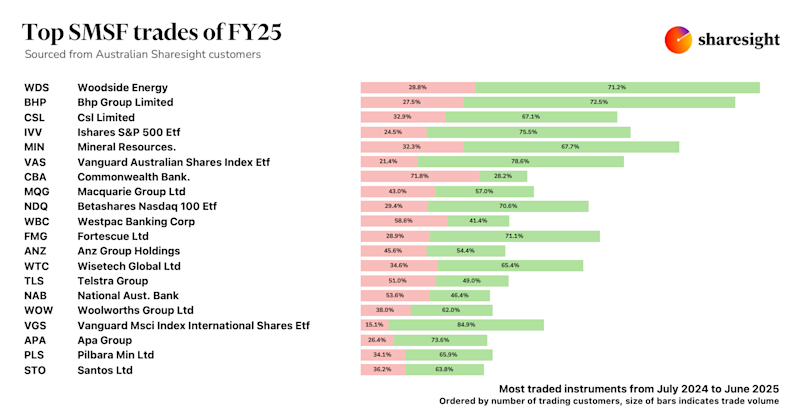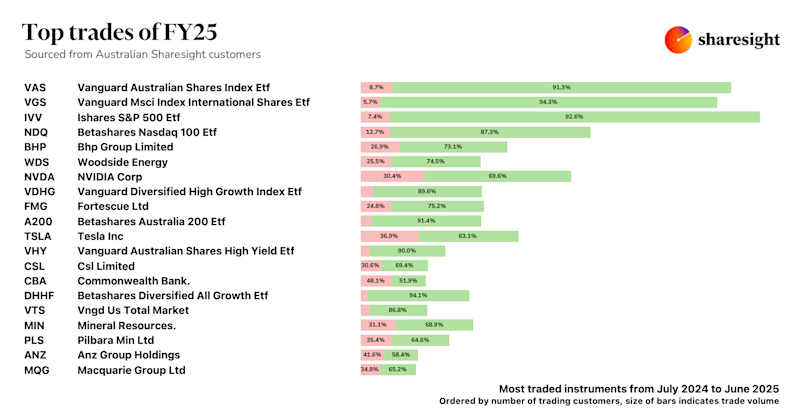4 reasons SMSF trustees should be tracking dividends
Investing in dividend-paying stocks through a self-managed super fund (SMSF) is a common strategy adopted by trustees, particularly when these dividends include franking credits that carry potential tax advantages. For SMSFs in the drawdown phase, dividend stocks can also be an attractive source of extra income in retirement. However, it is important to remember that with dividends come tax implications, and SMSF trustees need to track their dividends not only for tax purposes, but also to monitor their expected future dividend income and to get the complete picture of their investment portfolio performance.
This article will explain the 4 reasons why SMSF trustees should be tracking dividends, and how using a portfolio tracker like Sharesight can help save SMSF trustees time and money running their SMSF.
![]()
1. Your broker doesn’t give you the information you need
Manually tracking your dividends can be a tedious and time-consuming process, especially because you can’t get the information you need from your broker. With dividend payouts for example, listed companies, exchange-traded funds (ETFs) and managed funds outsource the responsibility of tracking who owns shares and who is paid dividends to any of the six Australian share registries. This means that in order to record your payouts, you will either have to painstakingly sort through stacks of paper statements, access multiple online registries, or a combination of both.
Unfortunately, even if you have your dividends deposited into your brokerage account, the broker will not be able to calculate the dividend yield from it because they have no visibility on the source of the cash. Without using a portfolio tracking software, you will need to calculate your dividend yield manually, which can be complex and subject to inaccuracy, especially if you have a large portfolio.
With Sharesight, however, dividends and distributions are automatically tracked in your portfolio, as shown in the screenshot below. This means SMSF trustees can spend less time on tedious portfolio admin, and more time focusing on their investment decisions.
 Sharesight automatically records all of your dividend payments and shows their impact on your returns.
Sharesight automatically records all of your dividend payments and shows their impact on your returns.
2. Franking credits impact your dividend income
Franking credits can be a real asset for SMSF trustees. Received during an SMSF’s accumulation phase, franking credits can offset the tax payable on dividends, and can be used in general to reduce or eliminate taxes paid on SMSF income such as capital gains and rental income. This makes stocks with fully franked dividends a popular choice for SMSF portfolios. It is important, however, for SMSF trustees to understand the impact of franking credits on dividend income and how this affects their tax returns.
Manually calculating the tax implications of franking credits can be a time-consuming process. Once again, looking at the bank account the share registry deposits dividends to will be of no help, because it only lists the net amount paid. The share registry can provide you with the information you need, but you will still likely need to access multiple registries to create a portfolio-wide tax picture.
Sharesight helps SMSF trustees avoid this long-winded process by automatically recording franking credits and clearly differentiating between the net dividend and the tax credits, as can be seen in the screenshot below. This makes it easy for SMSF trustees to calculate the taxable income on their investments, without the hassle of trying to chase down and verify this information at tax time.
 Sharesight automatically tracks dividends on holdings, clearly showing the impact of franking credits on dividend income.
Sharesight automatically tracks dividends on holdings, clearly showing the impact of franking credits on dividend income.
3. DRPs affect your cost base
Some SMSF trustees choose to take advantage of dividend reinvestment plans (DRPs) as a way of growing wealth in their portfolio while avoiding costly brokerage fees. Unfortunately, reinvested dividends can make it complicated to calculate a portfolio’s returns due to their impact on a holding’s cost base.
Because DRPs are managed by share registries, this means brokers have no visibility into reinvested dividends, leaving it up to the investor to keep track of them. DRPs can be a pain to track manually because when dividends are reinvested, shares are purchased at the current market price (sometimes at a discounted rate). This means that the cost base and amount invested is always fluctuating, which will have an impact on capital gains tax (CGT) should you ever wish to sell your shares, not to mention the added layer of complexity in tracking your returns.
With Sharesight, investors can automatically track reinvested dividends, as seen in the screenshot below, including the ability to track residual dividends. This gives investors the freedom to enable DRPs on their investments without having to worry about the admin involved in tracking fluctuating cost bases for their portfolio.
 Investors can easily track reinvested dividends by switching on Sharesight’s Auto Dividend Reinvestment feature.
Investors can easily track reinvested dividends by switching on Sharesight’s Auto Dividend Reinvestment feature.
4. You need to view dividend income at a glance
Finally, for SMSF trustees who plan to rely on dividend income in their retirement, it is important to be able to view dividend income at a glance. Using a solution like Sharesight, not only is it easy to track dividends as they are paid, but you can also track the value of dividends that have been announced using the Future Income Report, pictured below. This can be a useful way for SMSF trustees to see their expected income from investments and prepare plans to reinvest funds or extract the income for living expenses.

Sharesight’s Future Income Report displays expected upcoming dividends and interest payments based on a user’s current portfolio.
Track your SMSF with Sharesight
Overall, using a portfolio tracker like Sharesight can be extremely valuable for SMSF trustees, as it gives you the ability to track the performance of both SMSF and personal investment portfolios to give you the complete investment picture of all of your investments in one place.
Plus, with automated dividend income tracking, including the ability to track franking credits, Sharesight makes it easy to calculate the dividend income generated from your investments.
This significantly lessens the time SMSF trustees need to spend searching for records and making manual calculations. Combined with Sharesight’s powerful tax reporting built for the needs of SMSF investors, trustees have more time to focus on making investment decisions and planning for their retirement.
Sign up for a free Sharesight account and get started tracking your SMSF investments today.

Disclaimer: This article is for informational purposes only and does not constitute a product recommendation, taxation or financial advice and should not be relied upon as such. Please check with your advisor or accountant before using Sharesight or any other tool for your SMSF, to ensure you meet the ATO’s compliance obligations.
FURTHER READING

Sharesight users' top 20 trades – June 2025
Welcome to the June 2025 edition of Sharesight’s monthly trading snapshot, where we look at the top buy and sell trades by Sharesight users in all markets.

Top SMSF trades by Australian Sharesight users in FY24/25
Welcome to our annual Australian financial year trading snapshot for SMSFs, where we dive into this year’s top trades by Sharesight users.

Top trades by Australian Sharesight users in FY24/25
Welcome to the FY24/25 edition of our Australian trading snapshot, where we dive into this financial year’s top trades by Sharesight users.